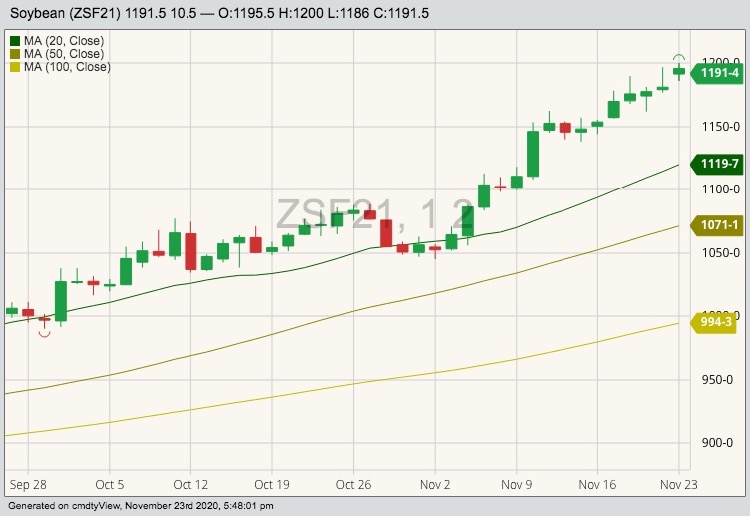Chicago | Reuters — U.S. soybean futures climbed to US$12 a bushel on Monday for the first time in four years as dry conditions in parts of Brazil and Argentina stoked concerns about supplies of the oilseed, analysts said.
Corn advanced, also lifted by worries about dryness in South America, and wheat futures followed the firm trend.
Chicago Board of Trade January soybean futures settled up 10-1/2 cents at $11.91-1/2 per bushel after touching $12 in opening moves, the highest price for a most-active soybean futures contract since June 2016 (all figures US$).
Read Also

BASF cuts 2025 outlook as tariffs weigh on global economy
Germany’s BASF said on Friday that it was lowering its full-year outlook, citing weaker-than-expected global economic growth and reduced demand for its chemicals due to U.S. tariffs.
CBOT March corn ended up five cents at $4.33-1/4 a bushel and March wheat finished up five cents at $6.04-1/2 a bushel.
Weekend rains were limited to far northern areas of Brazil’s soy belt, space technology company Maxar said in a crop weather note, and forecasts for this week were not much better.
“Rainfall amounts are expected to be light in most areas, which will maintain dryness concerns across most of Brazil, stressing corn and soybeans,” the Maxar note said.
Brazil is the world’s top soybean exporter and Argentina is No. 3 after the United States.
The Chicago soybean futures forward curve shows prices have jumped for all contracts through to the middle of next year.
Corn futures drew support from fresh export demand. The U.S. Department of Agriculture (USDA) confirmed private sales of 334,000 tonnes of U.S. corn to unknown destinations, the latest in a series of daily corn sales announcements.
“Corn is also firm on poor South American crop weather, including in Argentina, with more export demand also expected, with U.S. corn looking the cheapest in the world,” said Matt Ammermann, StoneX commodity risk manager.
CBOT wheat followed the strength in corn and soybeans, but gains in K.C. hard red winter wheat were capped by weekend rains that bolstered wheat crop prospects in parts of Kansas and Oklahoma.
However, after the close, USDA’s weekly crop progress report showed U.S. winter wheat ratings declined in the latest week. USDA rated 43 per cent of the crop in good to excellent condition, down from 46 per cent a week earlier, bucking analyst expectations for a one-point improvement.
— Julie Ingwersen is a Reuters commodities correspondent in Chicago; additional reporting by Michael Hogan in Hamburg and Naveen Thukral in Singapore.















